Beluga Sturgeon (Huso huso)
Underwater video of Beluga Sturgeons with Stellatus, Diamond, Siberian, Atlantic and hybrid sturgeons by Michael Emerton (huso466)
The Beluga Sturgeon (Huso huso) is the largest growing sturgeon species. Small juvenille Belugas are commonly available now but you should think very carefully before being tempted to buy one and be certain that you can provide a suitable home for a very large predatory fish and can afford the food bill. It may look cute in the shop now but it will grow very fast and you will find it very difficult to rehome when it outgrows your pond. It would be better to find a species that will be able to grow to maturity in the pond you have. Please check the other species pages on this site to help you identify which ones would do best in your pond.![]()
Keeping the Beluga Sturgeon with smaller fish/animals is risky as it lives by one rule: 'If it fits in my mouth I can eat it'. Also, a fondness for wild fowl can upset the local ecology.![]()
Extra oxygenation in the summer months is essential so an air pump system is a must. Beluga Sturgeons do not tolerate strong treatments such as formalin.![]()
Description
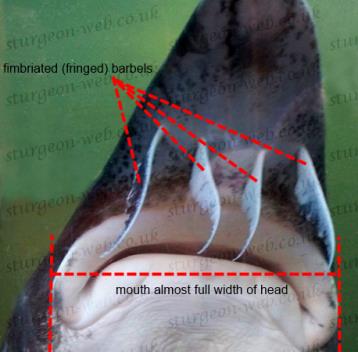
Huso huso has fimbriated (fringed) barbels and a wide mouth. Photo by Michael Emerton.
The Beluga Sturgeon (Huso huso) is a very large impressive fish. It is the fastest growing sturgeon species, farm grown specimens growing much faster than they would in the wild. A two year old farmed Beluga Sturgeon can be over 1m long (3ft+) and a four year old closer to 2m long (6ft+) and 35-40kg (75-100lbs) but a wild fish may take more than ten years to reach 2 meters. The beluga sturgeon is a long lived species, living over 100 years.![]()
Although reported to grow to 10m in length and weigh up to 2000kg, the largest recorded Beluga, caught in the Volga estuary in 1827, was a female measuring 7.2m in length and weighing 1,476kg.![]()
Huso huso has 9-17 dorsal scutes, 37-53 lateral scutes, 7-14 ventral scutes, 48-81 dorsal fin rays and 22-41 anal fin rays. The short snout is wide and rounded at the tip. The barbels are fimbriated (fringed) and the mouth is almost the full width of the head. Skin colour is steel-blue to grey-black, slightly lighter sides and pale belly. The dorsal scutes are white to cream in colour.![]()
Recommended Pond Size
If you want to keep Beluga Sturgeons in a pond you will need a pond of at least 15,000 gallons (68,000 litres) and plenty of money to meet the huge food bill. Beluga Sturgeons need a lot of feeding if they are to leave your other fish alone, a 2m Beluga Sturgeons can easily eat an 18 inch koi and will if it's hungry. The adult size of a pond-kept specimen is 2.4-3m (8-10ft) and it could weigh in at around 100kg (220lbs).![]()
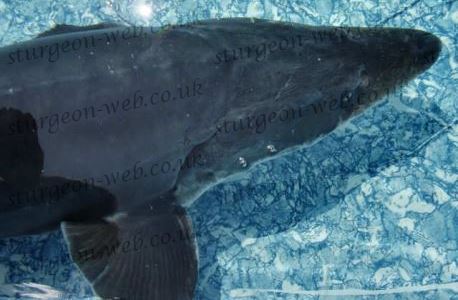
Beluga Sturgeon (Huso huso)
Food & Feeding
Sturgeons DO NOT, as some people would have you believe, eat banket weed or 'clean the bottom of the pond'. Sturgeons need to be fed all year round, they need 2-3% of their body weight of good quality food per day in the summer, less in the winter.![]()
A healthy sturgeon diet must contain a high level of animal protein, sturgeons need a minimum protein content of 40% and an oil level of 15% or more. A a small percentage of the protein can be obtained from soya but the majority needs to be from fishmeal or other animal sources.![]()
Pellet to Sturgeon size:
- 2mm pellet Starter Diet Sturgeon 10-20cm (4-8in)
- 3mm pellet Sturgeon 20-36cm (8-14in)
- 4.5mm pellet - sturgeon size 30-50cm (12-20in)
- 6mm pellet Sturgeon 36-61cm (14-24in)
- 8mm pellet Sturgeon over 61cm (24in)
Stellatus (Acipenser stellatus) and Sterlets (Acipenser ruthenus) have smaller throats; use a size smaller for them.
Buy sturgeon food pellets from Orchard Fisheries »
For more information feeding your sturgeon see our Sturgeon Food and Feeding page.![]()
Health Issues
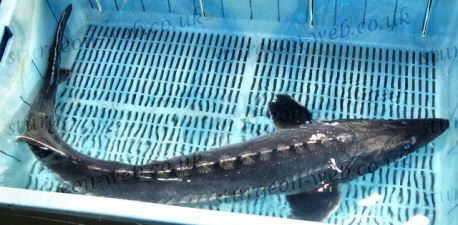
Juvenile Beluga Sturgeon (Huso huso)
The most common sturgeon health problems are food and/or oxygen related, get these two vital things right and your sturgeons should remain fit and healthy.![]()
Use an oxygen test kit to make sure there is enough oxygen in the water. Follow the instructions that come with the kit to ensure correct results. Do not assume that there is plenty of air just because you have an air pump running. Many things can affect the amount of dissolved oxygen in the water so testing is the only way to be certain. Warm water holds less oxygen than cold water so be vigilant during hot weather, especially stormy nights when the oxygen may drop to dangerously low levels suddenly.![]()
Feed your sturgeon plenty of the correct food all year round. For more information about feeding your sturgeon see our Sturgeon Food and Feeding page.![]()
Avoid strong chemical treatments such as formalin/formaldehyde, Potassium permanganate, Copper sulphate or any treatment that states not to be used with Golden Orfe (Leciscus sp.) or Rudd (Scardinius reythrophathalmus), these will probably kill your sturgeon. Salt is the safest treatment to use with sturgeons. For more information about treating your sturgeon see our Medications and Treating Sturgeons page.![]()
Provide the best possible water quaility for you fish. Run the pump and filtration all year round and keep a spare back up pump in case of main pump failure. For more information about water quality see our Water Quality page.![]()
Video of Beluga Sturgeon (Huso huso) at Jacobs in Meerdonk by steurenspeciaalzaak
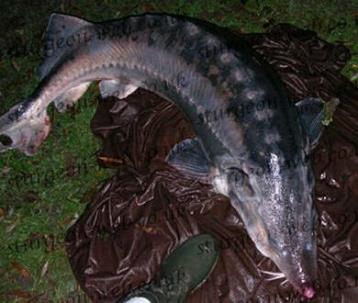
A 4 year old 38kg 1.65m long Beluga Sturgeon (Huso huso)
Wild distrubution
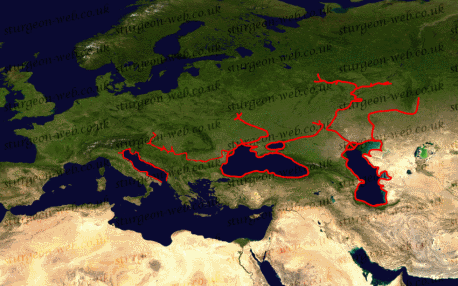
Beluga Sturgeon (Huso huso) wild distrubution map
The Beluga Sturgeon (Huso huso) is an Asian and European species found in the Caspian Sea, Black Sea and Sea of Azov including many of their tributaries. Historically the Beluga inhabited the Adriatic Sea and its tributary the Po River but is now thought to be extinct in this area. An andronomous species, the Beluga sturgeon spends the winter at depths of up to 100 meters, moving to the warmer food rich coastal shallows in summer. The Beluga can also be found in middle and upper river areas during migration and spawning times.![]()
Huso huso is listed as Critically Endangered on the IUCN Red List of Threatened Species.![]()
Taxonomy
Kingdom: Animalia
Phylum: Chordata
Subphylum: Vertebrata
Superclass: Osteichthyes
Class: Actinopterygii
Subclass: Chondrostei
Order: Acipenseriformes
Suborder: Acipenseroidei
Family: Acipenseridae
Subamily: Acipenserinae
Genus: Huso
Species: Huso huso Linnaeus, 1758
Common names
Beluga, Beluga Sturgeon, European Sturgeon, Giant Sturgeon, Great Sturgeon, Russian Sturgeon
Links
Encyclopedia of Life | FAO Species Fact Sheet | Fishbase | ITIS | Pond Life | World Register of Marine Species
Written by Terry White & Graham Quick
Contents
Home
Sturgeon Species
Sturgeon Care
Sturgeon Health
Water Quality
Our Other Sites

Copyright © 2000-2024
www.sturgeon-web.co.uk
All Rights Reserved.
Protected by UK Copyright Service Registration No:311386
